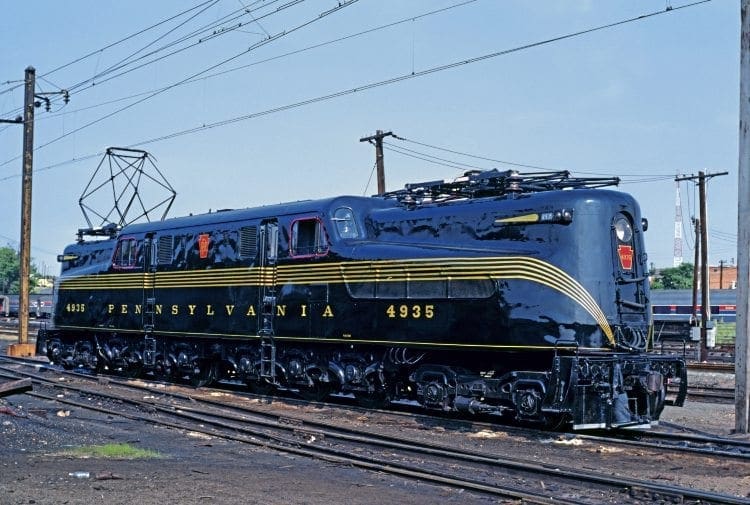
Words: Robert Humm
The incomparable ‘Pennsy Class’ ‘GG-1’ passenger locomotives were the apogee of electric traction development in the USA.
Robert Humm relates their history and that of the Pennsylvania electric railway network.
In the beginning, electric rail traction in the United States was confined to low-voltage streetcars and small industrial freight operations.
The first main line electrification was the Baltimore & Ohio’s three-mile long Howard Street Tunnel route in Baltimore, opened in July 1895. For the first time this demonstrated that electric traction was capable of meeting the demands of heavy duty main line railroading at a lower operating cost than steam power.
Yet, despite all the advantages, the huge infrastructure costs meant that electrification was restricted to the wealthiest railroads or those with severe operating conditions.
A unified main line electric network failed to develop in North America in the way it did in many parts of Europe. Subsequent developments in diesel and tunnel ventilation technology led to the abandonment by the late 20th century of all long-distance electric railways apart from the North East Corridor between Washington and Boston.
In the eastern states the New York Central and the Pennsylvania were bitter rivals for the vast and lucrative New York to Chicago traffic.
On the passenger side the NYC, though a slightly smaller company, had the advantage of a passenger station right in mid-town Manhattan. Its baroque Grand Central Station, opened in 1871, was shortly to be replaced by the even more magnificent Grand Central Terminal. The new station would be all-electric, a decision forced upon the NYC by legislation but one that nevertheless would provide a further competitive edge and a valuable sales weapon.
Anachronism
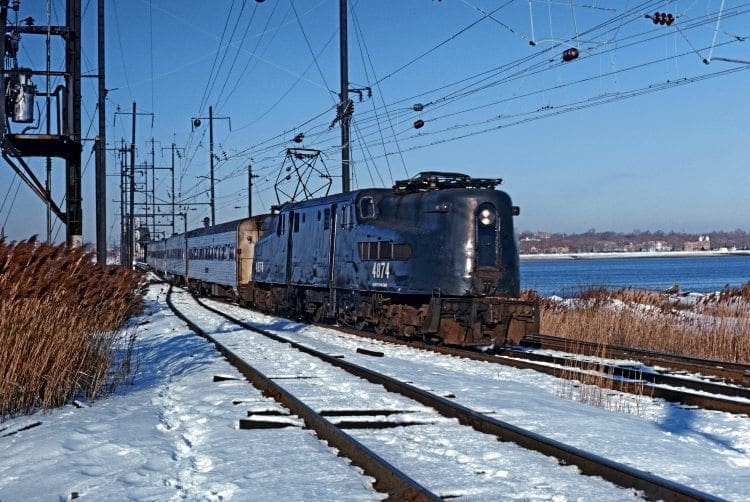
By contrast the Pennsylvania Rail Road (PRR) had no proper New York City terminus at all. For decades it had been stuck at the grim Exchange Place station on the Jersey City waterfront on the west side of the Hudson River.
Passengers were then obliged to take one of the cross-river ferries to lower Manhattan, a journey that could add between 15 and 60 minutes to the destination.
Such an anachronism was an anathema to the modern PRR. At the turn of the 20th century it was at the height of its power and prosperity, operating 3,600 route miles in 13 states, financially rock solid, paying good dividends to its stockholders, and at the forefront of railroad technology. Prestige demanded a similar presence in central Manhattan and the success of the Howard St Tunnel pointed the way.
Alexander Cassatt, president of the PRR, conceived a bold plan. There would be a new subterranean main line leaving the old Exchange Place route five miles out at a station later known as Manhattan Transfer.
The line would burrow beneath Bergen Hill and under the Hudson River, and take an east-west route beneath the streets of central Manhattan with a station at 7th Avenue and 31st Street to rival Grand Central in size and magnificence.
From Penn Station the line would continue as four tracks under the East River to join the Pennsy subsidiary Long Island Railroad at Flatbush Avenue, Brooklyn.
A vast new train servicing yard at Sunnyside, in the Borough of Queens, was also planned. Only electric traction made this underground scheme practicable. The cost was estimated at $120million, perhaps the equivalent of 10 or 12 billion dollars at today’s prices.
The New York City scheme was completed in 1910, and we may note that the East River tunnels were built by the British firm S Pearson & Son Ltd. The system of electrification was third rail direct current at 675 volts, by then a tried and tested technology.
Although some pioneer 11,000v AC overhead had been installed on the New Haven Railroad in 1905-07 it was still then too much of a novelty for the Pennsylvania to risk using it on its showpiece. Principal motive power at that time comprised 66 Class ‘DD1 2-B’ (4-4-0) side rodders, close coupled in pairs back to back.
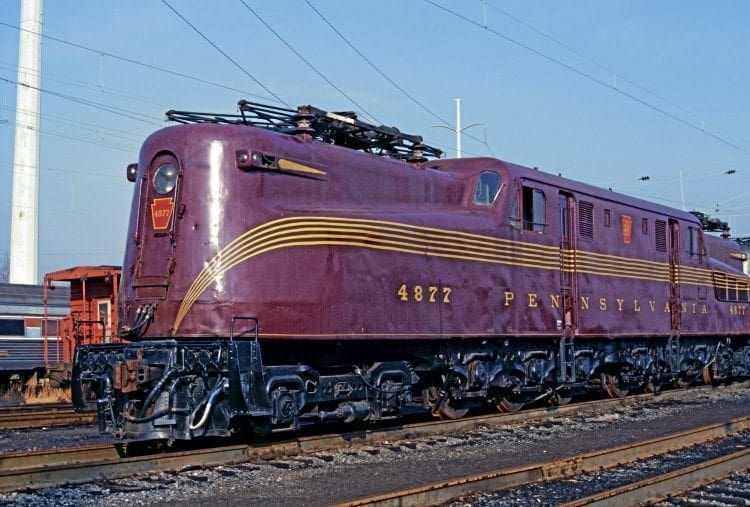
Disadvantages
That was by no means the limit of the Pennsylvania’s electric ambitions. As early as 1908 the company considered electrification to Pittsburgh.
Matters were delayed by the Great War, but by the early 1920s attention was focused instead on the 93 miles southwards to Philadelphia, where PRR had already electrified the suburban network, and then onwards to Baltimore and Washington.
By this time the technical disadvantages of the third rail for long-distance electrification were becoming apparent. High voltage AC had been adopted with success elsewhere, including Boston & Maine RR (1911, 11kv), Virginian Railway (1925, 11kv), Norfolk & Western RR (1915-24, 11kv), and Great Northern Railway (1927, 22kv).
The huge new Pennsy programme, which also included conversion of the original Manhattan/River Tunnels route to overhead, involved 325 route miles and some 1,300 track miles. It was the world’s largest electrification programme thus far.
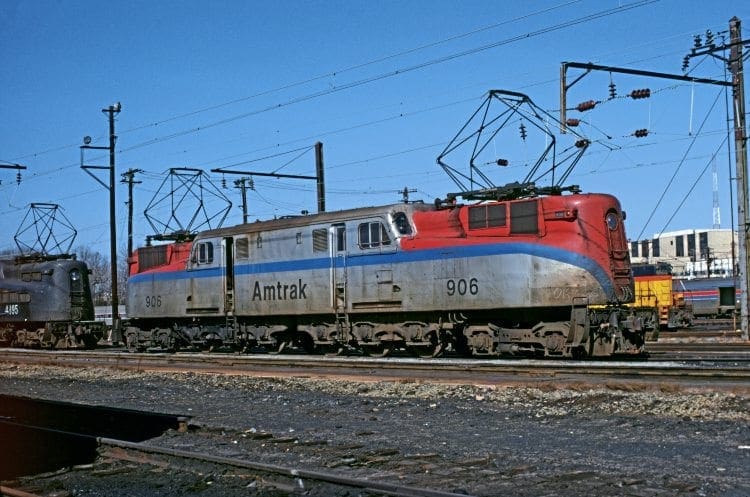
The first part of the programme, between Penn Station, Manhattan and Philadelphia, was energised in stages during late-1932 and early-1933, the inaugural trains starting on January 16, 1933.
The Philadelphia to Washington section did not open until January 28, 1935, delayed by the inability of the PRR to raise sufficient funds during the Depression. Electrification of the western main line between Paoli (near Philadelphia) and Harrisburg, and other routes and branches followed in 1937 and 1938.
At its greatest extent the electric network of 2,150 track miles was the longest in the country, far exceeding runner-up Milwaukee Road’s 892 miles.
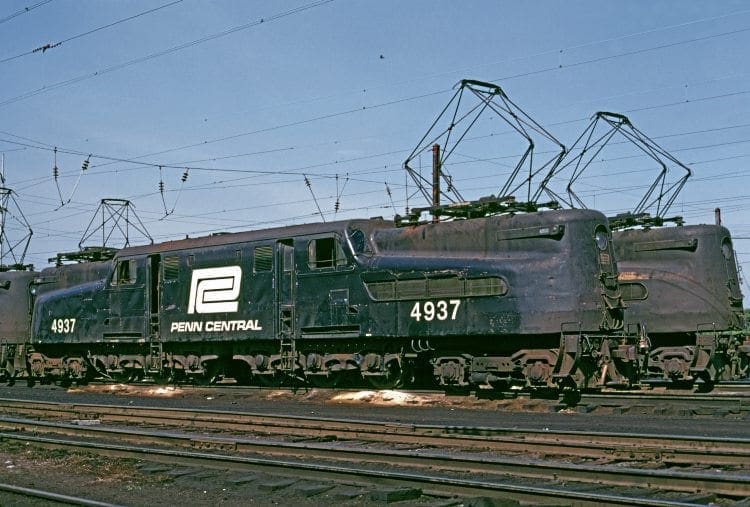
The first AC electric locomotives were, by Pennsy standards of excellence, a mediocre lot. The principal heavy passenger class was a utilitarian-looking box-motor with cabs at both ends. They were 3,750hp 2-C-2 (4-6-4) machines with the 72-inch drivers in a rigid frame in emulation of their steam predecessors.
Two prototypes, delivered in August 1931, were designated Class ‘P-5’, and the slightly modified 90 production series, of which deliveries began in mid-1932, were designated Class ‘P-5a’. The main order was split between the railroad’s own shops at Altoona (11), General Electric (25), and Baldwin-Westinghouse (54).
Geared to a maximum of 90mph, the intention was that the ‘P-5a’s’ should match the haulage capacity of the ‘K4s’ class Pacifics but at higher speeds. In service they proved woefully deficient.
They were incapable of more than 75mph, generated severe lateral forces that damaged the track, and suffered cracked axles.
By the late-1930s most were relegated to freight haulage. They still left something to be desired, but had to soldier on for another 35 years in the absence of anything better.
The other two classes, again both of rigid frame configuration, were the ‘O1’ Class 2-B-2 for lighter passenger duties, hitherto performed by Atlantic 4-4-2s, of which eight were built in 1931/32; and Class ‘L6’ 1-D-1 for general freight duties, built by Lima.
The former, with only half the total weight on the drivers, were ‘slithery’ when handling more than the lightest trains. The latter was never multiplied beyond the two prototypes once their intended duties had been assumed by the ‘P-5a’s’.
Defects
It was not until after the start of electric operations that the worst defects of the ‘P-5a’s’ became apparent. In the autumn of 1933 all 62 of the class by then in service were temporarily withdrawn for modification, to be replaced by the ‘K4s’ Pacifics that they had superseded.
Track tests were carried out on a section of line at Claymont, Delaware, using several different locomotives. By and large the ‘P-5a’ faults were remedied and they returned to service by the end of the year, but it was clear that they were not going to achieve the Pennsy’s main electrification objective: fast and faultless haulage of heavy passenger trains.
Something much better was required urgently.
To round off the ‘P-5a’ story, in November 1934 Altoona outshopped the first of its allocated order of 11 in a greatly modified form, number 4780. Retaining the 2-C-2 wheel arrangement, the boxy body was replaced by a smoothly contoured centre-cab design that was based on aerodynamic principles.
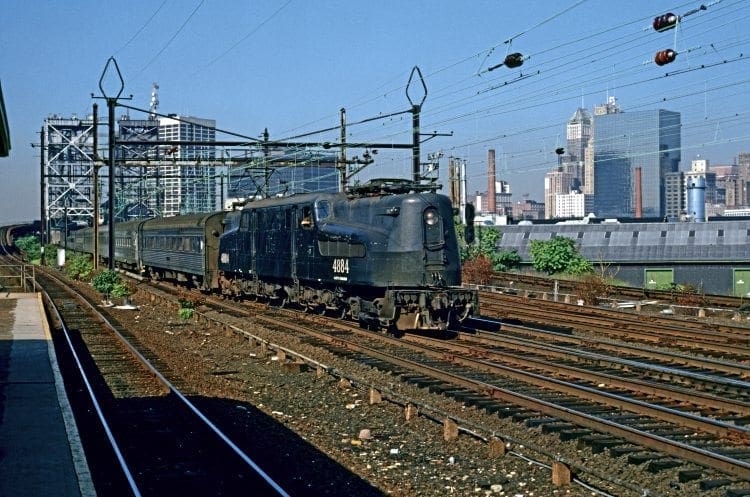
The central driving position was adopted in order to give the crew greater protection in the event of an accident. It was the forerunner of the famous ‘GG-1’ body shape.
The rest of the class were delivered by the three builders between January and April 1935. They were always classified as ‘P-5a’ (Modified), no separate designation being given. Withdrawal of both variants took place between 1961 and 1965, a few of the original box-motor design outlasting the Modifieds.
Turning now to the ‘GG-1’ history proper, late in 1933 the Pennsylvania motive power department collaborated closely with General Electric and Westinghouse to establish the ideal second-generation passenger locomotive to replace the ‘P-5a’ in frontline service.
The specification was for a locomotive more powerful than the ‘P-5a’, a lower axle-loading, and capable of speeds of at least 100mph. The protected driving position of the Modifieds was adopted though the greater body length permitted twin cabs behind long bonnets instead of a single central cab.
Opinions differed as to the correct solution. Westinghouse came up with a 5,000hp rigid frame 2-D-2 with 62-inch drivers, allocated the type designation ‘R1’, that in fundamentals was an enlarged ‘P-5a’ beneath a modern bodyshell. Axle-load was the same as the ‘P-5a’, 60,000lbs (30 short tons), Westinghouse being convinced that a high axle loading contributed to good performance.
The General Electric proposal was a 4,620hp articulated 2-C+C-2 (4-6-6-4) with 57-inch drivers, to which the Pennsylvania gave the designation ‘GG-1’. In the PRR steam locomotive nomenclature ‘G’ was a 4-6-0, thus the locomotive was regarded as a pair of 4-6-0s back to back. The design was based upon the smaller New Haven Class ‘EP3’ of the same wheel arrangement, built by Baldwin-Westinghouse in 1931. An example was borrowed for testing and re-geared from 80mph to 120mph. It proved to be an eye-opener and recorded a substantial reduction in lateral forces compared with the ‘P-5a’.
One locomotive of each design was commissioned and both were assembled at the Baldwin Locomotive Works.
The reason for GE relinquishing their share of the job to a rival builder is unclear. It was possibly the wish of the PRR at the prototype stage to have no more than one set of the complex wooden formers upon which the bodyshell was assembled.
‘GG-1’ No. 4899 (later 4800), BLW works number 61816, was delivered in August 1934. Class ‘R1’ No. 4800 (later 4899 and subsequently No. 4999), BLW works number 61817, followed in September 1934.
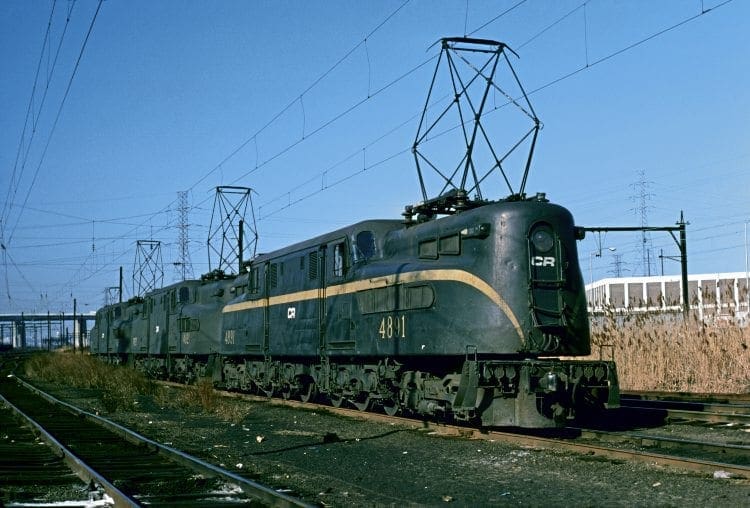
They were tested for 10 weeks in normal service between New York City and Philadelphia and on the test track at Claymont.
For performance there was not much to choose between them, but the long rigid wheelbase of the ‘R1’ tended to cause derailments on tight curves and switches, and for that reason the ‘GG-1’ was selected. Nevertheless the powerful ‘R1’ was taken into PRR stock and remained in service, mainly in the New York City area, until October 1956.
The initial order for 57 locomotives was divided between General Electric, Westinghouse and Altoona. The GE order comprised 14 locomotives (PRR 4801-4814), built and engined at the company’s own plant at Erie, Pennsylvania. Delivery was between May and July 1935.
Westinghouse’s order was for 25 locomotives (PRR 4815-4839). In keeping with long-standing
practice Westinghouse supplied the electrical components and control equipment, while the structural and mechanical parts were subcontracted to the joint venture Baldwin-Westinghouse concern.
Assembly took place at Baldwin’s vast Eddystone locomotive Works, near Philadelphia. The electrical components were installed at Altoona and the locomotives carried both Baldwin and Altoona works numbers (respectively 61840-61864 and between 4285-4324). Delivery was also completed by July 1935.
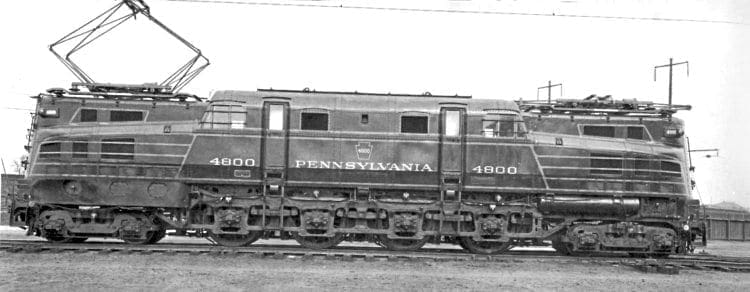
Outstanding
The remaining 18 locomotives (PRR 4840-4857) were built at Altoona, using both GE and Westinghouse electrical equipment, and delivered between April and June 1935.
Thus in less than four months the PRR received a fleet of 58 (including the prototype) of highly capable express locomotives, an outstanding achievement by any reckoning. The cost of each locomotive was $250,000.
Starting in 1937 a further 81 ‘GG-1’s’ were constructed, all at Altoona. Five were delivered in that year, nine in 1938, 17 in 1939, 20 in 1940, two in 1941, 17 in 1942, and a final 10 in 1943. As before, the electrical equipment was supplied by both GE and Westinghouse.
Looking at the locomotives in detail, the principal dimensions were: length 79ft 6ins between couplings, rigid wheelbase 13ft 8ins and total wheelbase 69ft. All-up weight was 460,000lbs (230 short tons).
The rolling chassis consisted of a pair of six-wheel, one-piece cast steel frames, manufactured by the General Steel Castings Corporation. At their inner ends there were joined by a ball and socket coupling in the same way as a ‘Mallet’ steam locomotive. At each outer end was an unpowered four-wheel truck pivoted from a long extension of the main frame.

The ‘GG-1’ was powered by 12 385hp motors, two to each axle, and the success of the class has sometimes been ascribed to this multiplicity of small motors.
Transmission was by means of a ‘quill’, a shroud around the axle and connected to the driving wheels by a spring and cup device. The motors themselves were mounted rigidly on the cast frames. Our diagram illustrates the principle.
Main body frames comprised a pair of warren trusses from sill to cantrail, and extending the whole length of the locomotive except for the outer ends of the bonnets. Cast steel transoms with manganese facings provided pivoting points for the body.
The carbody was attached to a light framework outboard of the main frames. Pantographs were mounted above each bonnet, the operational pantograph being the rear one in the direction of travel.
The original body shape for the ‘GG-1’ as well as the ‘P-5a Modifieds’ had been devised by Donald R Dohner. Between the completion of the prototype ‘GG-1’ and the start of the production run the rising industrial designer Raymond F Loewy enters the story.
Loewy, born in Paris in 1893, emigrated to the USA in about 1919 and for 10 years was employed as a fashion illustrator. In the late-1920s he began what he later described as “a one-man industrial crusade under the aegis of good taste”.
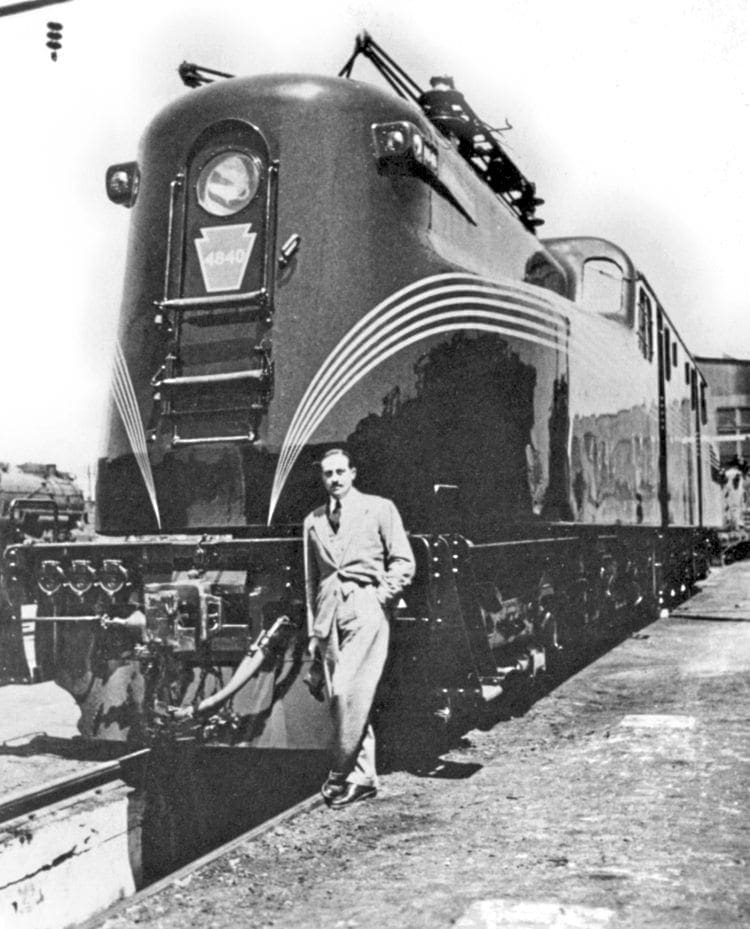
The myth is that Pennsy sought out the services of the great man. It is more to the truth that Loewy was short of work and managed to hustle his way into the ‘GG-1’ project via a small commission to redesign the rubbish bins at Penn station. Eventually he was permitted to submit a proposal in the form of sketches and a clay model.
His concept for the locomotive was that “brute force can have a very sophisticated appearance of great finesse and at the same time be a monster of power”. Thus legends are created from fine words.
PRR management rather surprisingly accepted this revolutionary approach. The outcome was a sleek butt-welded one-piece shell instead of overlapping riveted panels, the first time that automobile construction methods had been applied to a locomotive.
Angles became smoothly rounded contours, and there was careful attention to doors, windows , steps, handholds, and other components, to reduce air resistance.
A further innovation was to replace the inelegant mess of body lining of the prototype. The iconic five-line gold pinstripe ‘speed whiskers’ devised by Loewy had nothing to do with aerodynamics, but defined the look of the locomotives like nothing else.
They influenced the appearance of modern motive power worldwide for the next 30 years. In Great Britain alone think of the Stanier Pacifics, the Bulleid electric locomotives, the prototype ‘Deltic’ and hundreds of first-generation diesel multiple units.
Keystone
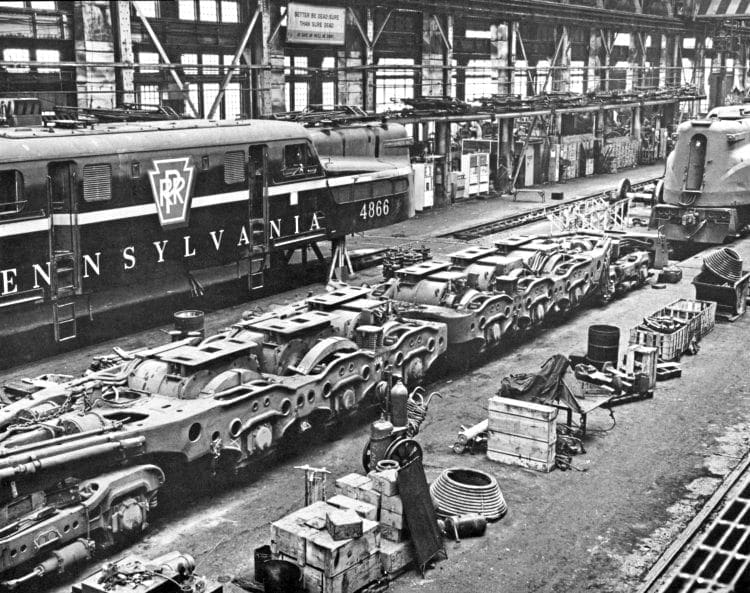
ROBERT HUMM COLLECTION
Company identity was provided by the word PENNSYLVANIA in stretched out sans serif letters along the length of the lower bodyside, flanked by the locomotive number towards the ends of the bonnets. Postwar this reverted to the Pennsy’s traditional Clarendon serif letterform, and in the 1960s by a closer-spaced but bolder version.
The original locomotive livery was Brunswick Green (a much darker shade than we are accustomed to here, and almost black under certain light conditions). In 1952 it was changed to Tuscan Red to match the PRR coach livery, and subsequently the five stripes were replaced by a single broad yellow stripe intersected by a huge Pennsy keystone emblem on the body centre panel.
In the dark and austere days of the Penn-Central merger the livery was black without any adornment apart from the unseemly wormlike PC logo.
Most of the 30 bought by Amtrak in 1971 kept the dreary black livery, however seven received their ‘Platinum Mist’ livery, while some retained by Conrail were repainted in their mid-blue and white scheme.
Introduction of the ‘GG-1s’ revolutionised Pennsy passenger services. They were masters of any load imposed on them, 18 air-conditioned cars grossing 1,000 tons being quite normal.

By April 1935, all 191 daily trains between New York, Philadelphia and Washington were in the hands of the new locomotives. Running times were reduced significantly. Half an hour was clipped off the ‘Congressional Limited’ between New York and Washington, 45 minutes off the famous Broadway Limited’ and no less than two hours off the ‘Pennsylvania Limited’.
This was achieved by both higher maximum speeds and higher average speeds. New York to Washington passenger revenues rose 5.6% in 1935 alone.
Although designed as passenger locomotives the ‘GG-1s’ were used from the beginning as motive power for fast merchandise and perishable traffic from the south to the markets of the East Coast, cutting previous schedules by a quarter.
By 1938 it was estimated that PRR motive power costs had been cut by nearly $8m annually. Electric locomotives were significantly cheaper to maintain, were faster in turnround at terminals, and spent less time in inspection and repair.
Peak point
The ‘GG-1’s’ came into their own after the entry of the United States into the Second World War. Pennsy electrified territory was the strategic concentration area for the build-up of men, vehicles and supplies for the invasion of Europe.
Freight traffic rose 40% above pre-war levels and current consumption increased from 150,000 kilowatts every hour to 235,000 kilowatts. The company was hard pressed to find sufficient passenger cars, but 139 ‘GG-1s’ were more than enough to handle them; in the electric district there were fewer than 100 steam locomotives.
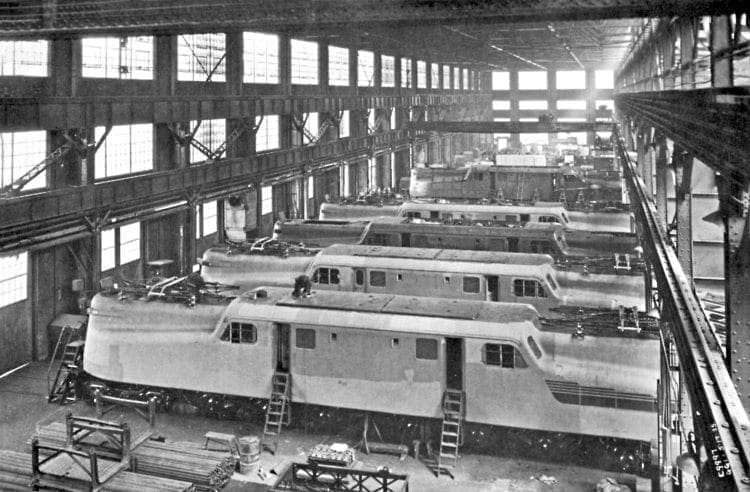
There was no repeat of the 1917 railway traffic crisis that had led to the temporary nationalisation of the industry.
1945 was the peak point of history for the ‘GG-1’s’ and the Pennsylvania electric network. The railroad wished to extend the overhead of the next 245 heavily trafficked miles from Harrisburg to Pittsburgh, but it was no longer the mighty financial power it had been in the first 30 years of the century.
Post-war high prices, wartime profits tax, the collapse of long-distance passenger train traffic in 1947/48, and the decline in investor confidence, meant that the money was never available.
A further factor was the availability of the main line diesel locomotive, now a potent force in railroad operation. The diesel-electric provided most of the benefits of the pure electric locomotive, was highly flexible, and did not require the huge capital cost of electrification infrastructure.
Mass production of diesel locomotives in the boom years of 1945-1955 meant their unit costs were lower than for electric locomotives. Only the Virginian, Great Northern and Milwaukee Road continued to buy electrics, and then in tiny numbers.

The year of decision was 1947. The PRR had either to extend the overhead to Pittsburgh and keep steam for the rest of the system, or go for mass dieselisation. It could not afford both. Dieselisation won and by the end of 1948, 590 diesels were on order, the money being scraped together (some of those diesels, now of preservation status, were unwise purchases and I hope to deal with two of them in a future article). No ‘GG-1’ would ever be seen in Pittsburgh.
Collapse
The ‘GG-1’ fleet continued to serve with legendary reliability in the Eastern district during the 1950s, though with the continuing loss of passenger business the first 57 of the class were re-geared to 90mph maximum for freight operation. Others were often seen on local and suburban duties, replacing life-expired multiple units.
Thirty years after they were first introduced the whole class was intact. Withdrawal started in March 1966 when Nos. 4804, 4831 and 4847 were retired and by the time Penn Central was formed in 1968, 19 had gone.
Following the Penn Central collapse in 1970 and the formation of Conrail out of the ruins, 30 ‘GG-1’s’ were bought outright by Amtrak for $50,000 apiece. They continued to be used on North East Corridor express passenger trains until replaced by the ‘AEM-7’ class in 1980, a fine record of 45 years service.
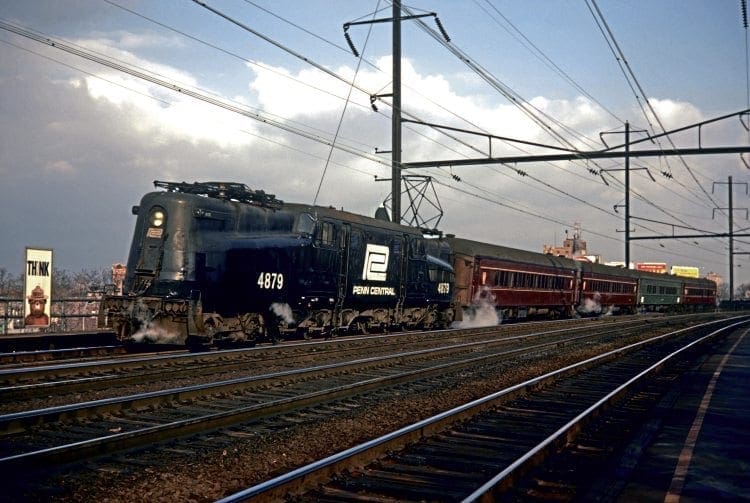
After many years of the locomotives being taken for granted by train watchers, a group named Friends of the GG-1 was formed in 1976 to restore one of the class to original condition. Amtrak selected No. 4935 to be given a thorough overhaul at the Wilmington repair facility. Amtrak paid for the extensive mechanical and electrical work and the Friends paid $9,000 for car body renewal, sandblasting, filling and painting.
On Sunday, May 5, 1977 the dedication ceremony took place at Washington Union station with Raymond Loewy, now a grand old man of 84, as the guest of honour.
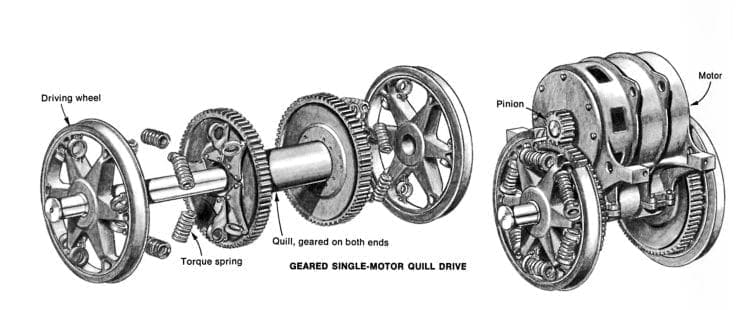

He said: “If I had to redesign it today, I don’t know what I would change. I would probably not change anything.” Locomotive No. 4935 is preserved today in its 1977 condition in the main hall at the Pennsylvania State Railroad Museum at Strasburg.
Conrail used its surviving 68 ‘GG-1’s’ until the end of electric freight traction in 1980. The last operational survivors were 13 assigned to New Jersey Transit for use on the New York & South Amboy branch. The last of those was withdrawn in 1983. Apart from 4935,
15 other ‘GG-1’s’ survive in museums, none of them operational. ■
The Railway Magazine Archive
Access to The Railway Magazine digital archive online, on your computer, tablet, and smartphone. The archive is now complete – with 123 years of back issues available, that’s 140,000 pages of your favourite rail news magazine.
The archive is available to subscribers of The Railway Magazine, and can be purchased as an add-on for just £24 per year. Existing subscribers should click the Add Archive button above, or call 01507 529529 – you will need your subscription details to hand. Follow @railwayarchive on Twitter.

GG-1 Data Panel
- Builder: GE, Westinghouse and Pennsylvania RR Altoona works.
- Build dates: 1934-1943
- Wheel arrangement: 2C+C2 (4-6-6-4)
- Length: 79ft 6in
- Width: 10ft 6in.
- Weight: 230 short tons
- Power collection: 11 to 13.5kV at 25Hz AC overhead
- Traction motors: 12 x GEA 627-A1, 385hp, quill drive
- Rating: 4,620HP
- Train heating fuel: 424US gallons
- Train heating water: 2,760 US gallons
- Max speed: 100mph passenger, 90mph freight
- Service operators: Pennsylvania Railroad, Penn Central,
- Conrail, Amtrak, New Jersey Transit
- Total produced: 139 (Nos. 4800-4938)
- Preserved: 16
ALTOONA OR JUNIATA?
The PRR locomotive shops were established at Altoona (between Harrisburg and Pittsburgh) in the 1850s for repair work. Locomotive construction started in 1866.
In 1888-1890 a major eastward extension was completed and, because it was beyond the city boundary, this was known as Juniata.
By 1904 all new locomotive construction was concentrated at Juniata, the original works then being utilised for passenger and freight car construction and repair.
By the time locomotive construction ended in 1946 Altoona-Juniata had become one of the largest railroad works in the USA.
In 1928 the separate Juniata name was dropped in favour of plain Altoona for the whole complex.
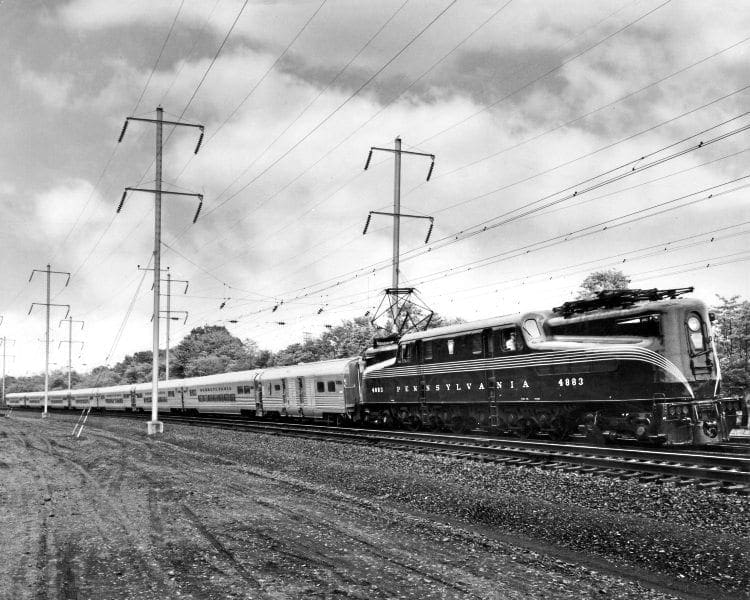
Revived
Following the PRR-NYC merger in 1968 the Juniata name was revived once more for the entire workshop district.
Most writers tend to use the two names interchangeably.
Today, Juniata remains as the principal overhaul and repair facility of the Norfolk Southern Railroad.
The ‘GG-1’ locomotives were built in the Altoona car shops, presumably because the assembly work was more akin to passenger car construction than the heavy boilermaking, forging, casting and riveting processes that took place in steam locomotive shops.
Locations of preserved GG1s
- 4800 Railroad Museum of Pennsylvania
(PA), Strasburg - 4859 Harrisburg station, PA
- 4876 B&O museum, Baltimore,
Maryland - 4877 Boonton, New Jersey
- 4879 Boonton, New Jersey
- 4882 National New York Central Railroad
Museum, Elkhart, Indiana - 4890 National Railroad Museum,
Green Bay, Wisconsin - 4903 Age of Steam Museum, Dallas
- 4909 Leatherstocking Railway Museum,
Cooperstown Junction,
New York (NY) - 4913 Railroader’s Memorial Museum,
Altoona, PA - 4917 Leatherstocking Railway Museum,
Cooperstown Junction, NY - 4918 Museum of Transportation, St Louis,
Missouri - 4919 Museum of Transportation,
Roanoake, Virginia - 4927 Illinois Railway Museum, Union,
Illinois - 4933 Central New York Chapter,
National Railway Historical Society,
Syracuse, NY - 4835 Railroad museum of Pennsylvania,
Strasburg


